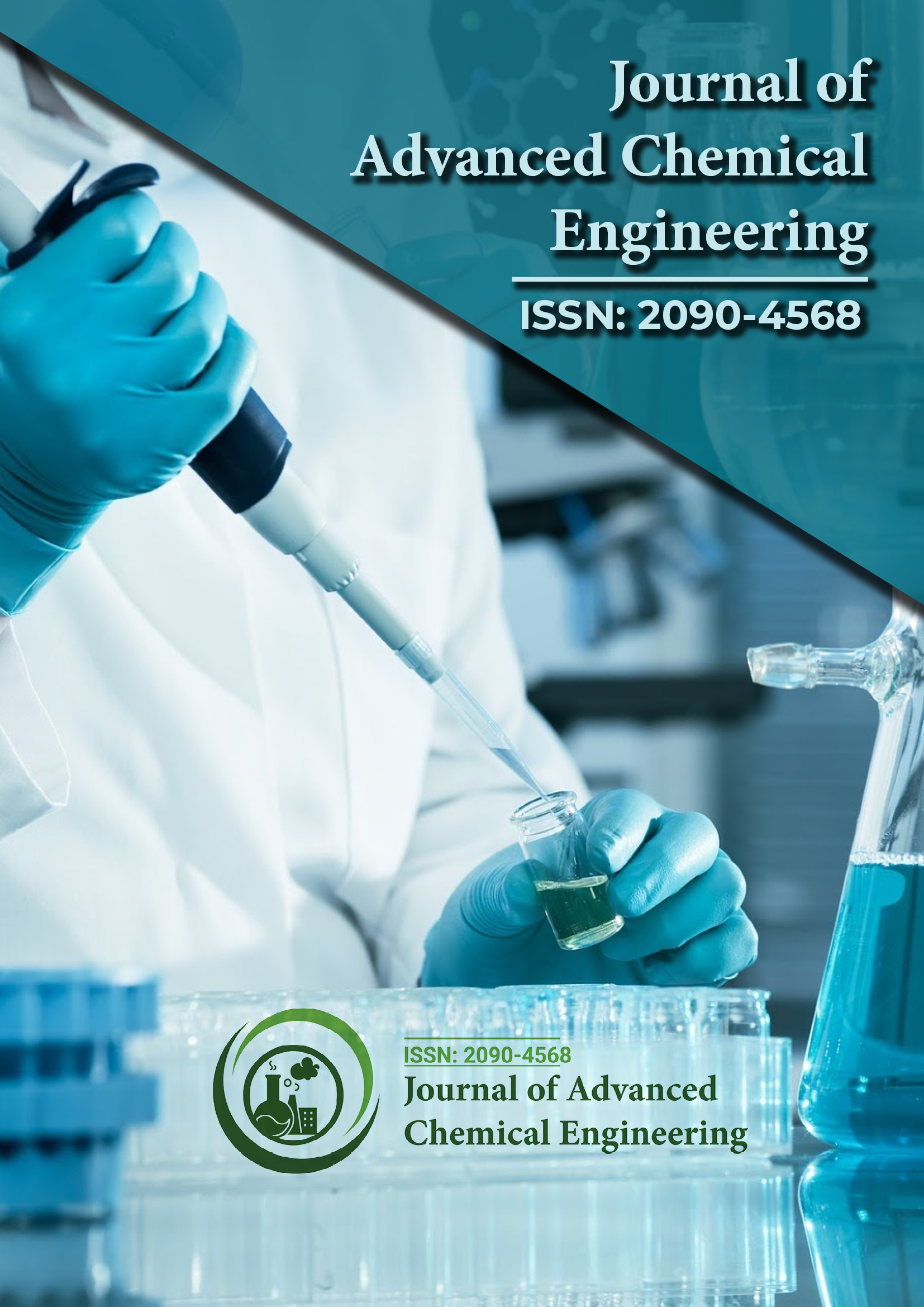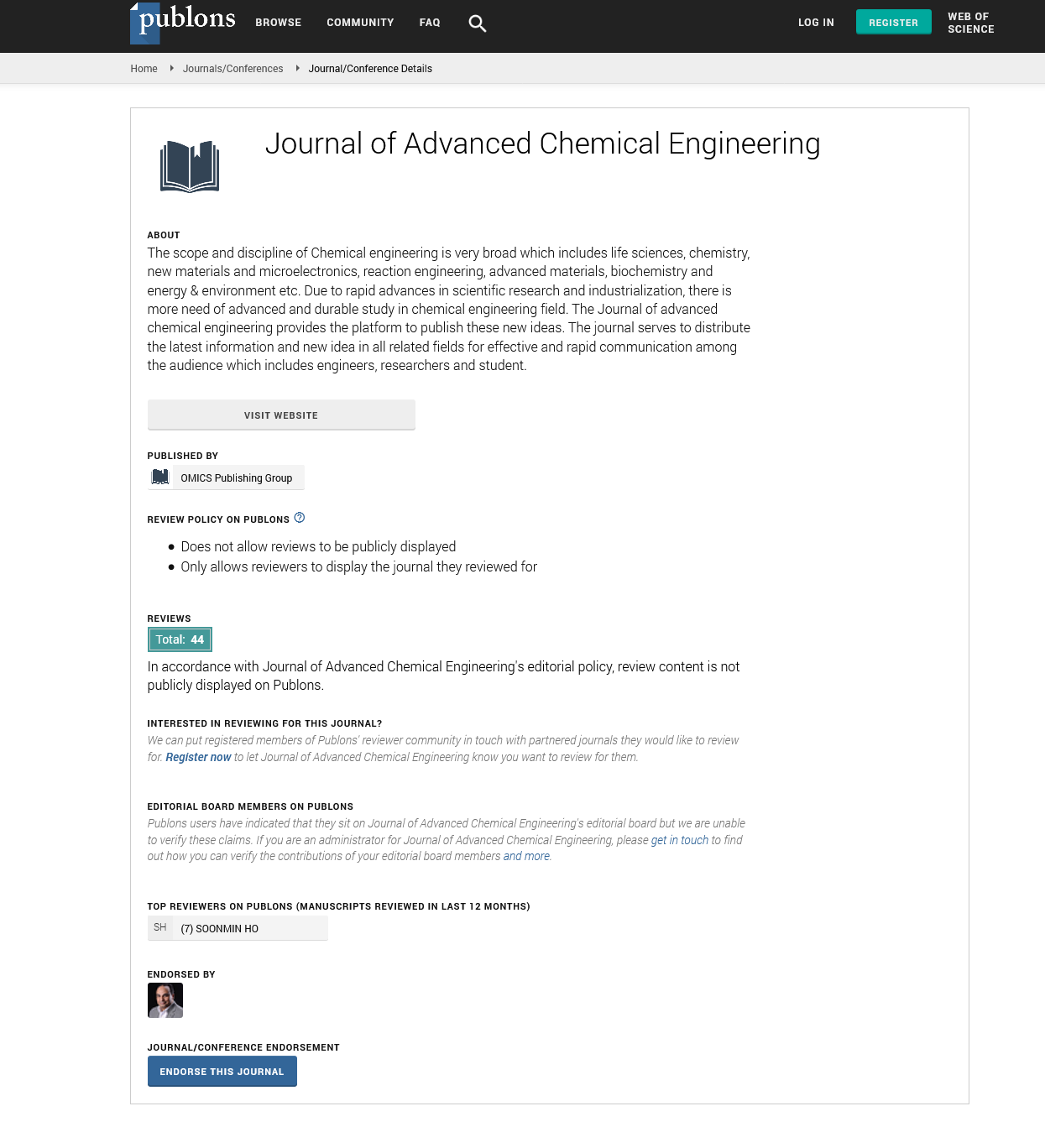Indexed In
- Open J Gate
- Genamics JournalSeek
- Smithers Rapra
- RefSeek
- Directory of Research Journal Indexing (DRJI)
- Hamdard University
- EBSCO A-Z
- OCLC- WorldCat
- Scholarsteer
- Publons
- Geneva Foundation for Medical Education and Research
- Google Scholar
Useful Links
Share This Page
Journal Flyer

Open Access Journals
- Agri and Aquaculture
- Biochemistry
- Bioinformatics & Systems Biology
- Business & Management
- Chemistry
- Clinical Sciences
- Engineering
- Food & Nutrition
- General Science
- Genetics & Molecular Biology
- Immunology & Microbiology
- Medical Sciences
- Neuroscience & Psychology
- Nursing & Health Care
- Pharmaceutical Sciences
Short Communication - (2025) Volume 15, Issue 1
Advancements in Plasma-Assisted Chemical Processes for Sustainable Manufacturing
Yasmine Haddad*Received: 03-Mar-2025, Manuscript No. ACE-25-29158; Editor assigned: 05-Mar-2025, Pre QC No. ACE-25-29158 (PQ); Reviewed: 19-Mar-2025, QC No. ACE-25-29158 ; Revised: 26-Mar-2025, Manuscript No. ACE-25-29158 (R); Published: 02-Apr-2025, DOI: 10.35248/2090-4568.25.15.363
Description
Plasma-assisted chemical processes are rapidly emerging as a transformative approach in chemical manufacturing, offering unique reaction pathways, energy efficiency, and environmental sustainability. Plasma, often referred to as the fourth state of matter, consists of a partially ionized gas containing electrons, ions, radicals, and excited species. These reactive entities enable chemical reactions that are often inaccessible or require extreme conditions under conventional thermal processes. Non-thermal or cold plasma, in particular, provides the advantage of highenergy electrons without significantly heating the bulk gas, making it highly effective for activating stable molecules such as nitrogen, methane, and carbon dioxide [1-3].
One of the most promising applications of plasma-assisted chemistry is in the fixation of atmospheric nitrogen to produce ammonia, a cornerstone of the global fertilizer industry. The traditional Haber-Bosch process, while industrially optimized, is energy-intensive and responsible for a significant share of global COâ?? emissions. Plasma-based nitrogen fixation offers a decentralized and electricity-driven alternative, using nitrogen and hydrogen or water vapor in dielectric barrier discharge (DBD) or microwave plasma reactors. Experimental setups have demonstrated ammonia synthesis at ambient pressures and moderate temperatures, with ongoing improvements in selectivity and energy efficiency through catalyst-plasma synergy.
Plasma activation is also proving valuable in the conversion of greenhouse gases such as COâ?? and CHâ?? into value-added chemicals. Dry Reforming of Methane (DRM), which combines COâ?? and CHâ?? to produce synthesis gas (a mixture of CO and Hâ??), typically requires temperatures above 800°C in thermal reactors. Plasma-assisted DRM achieves comparable conversion at significantly lower temperatures, enabling integration with intermittent renewable energy sources like solar and wind. Moreover, the plasma environment promotes the formation of unique reaction intermediates, leading to higher selectivity towards desired products in methanation, methanol synthesis, or Fischer-Tropsch reactions.
Another field witnessing the benefits of plasma chemistry is environmental remediation. Plasma processes are effective in breaking down Persistent Organic Pollutants (POPs), pharmaceuticals, and dyes in wastewater. The oxidative environment generated by plasma in water or air leads to the formation of hydroxyl radicals, ozone, and hydrogen peroxide, which rapidly degrade complex pollutants without the need for added chemicals. This has particular relevance in decentralized treatment systems for hospitals, industries, and rural communities, where conventional treatment infrastructure may be lacking [4-6].
Surface modification and functionalization of materials is yet another area where plasma plays a crucial role. By exposing surfaces to plasma discharges, engineers can tailor surface energy, roughness, and chemical functionality without altering the bulk properties. This is particularly important in applications involving polymers, textiles, biomedical devices, and membranes. Plasma-Enhanced Chemical Vapor Deposition (PECVD) enables the formation of thin, uniform coatings with enhanced durability, hydrophobicity, or antimicrobial properties.
The design and optimization of plasma reactors remains a central challenge in the scale-up of plasma-based chemical engineering. Reactor geometries, power supply configurations, gas compositions, and electrode materials all influence the type and density of reactive species generated. Computational Fluid Dynamics (CFD) coupled with plasma kinetic modeling is being employed to simulate and refine reactor performance. These tools provide insights into species transport, energy distribution, and surface interactions, facilitating the transition from laboratory-scale experiments to industrial applications [7-9].
Despite its promise, plasma technology still faces barriers to widespread commercialization. Energy efficiency must be improved to compete with mature thermal processes, particularly for bulk chemical production. Advances in power electronics, pulsed discharge technologies, and reactor insulation are being pursued to reduce energy losses and maximize electron utilization. Furthermore, the integration of catalysts into plasma reactors referred to as plasma-catalysis is a growing field aimed at lowering activation barriers and steering product selectivity. Materials such as perovskites, zeolites, and Metal-Organic Frameworks (MOFs) are being explored for their ability to withstand plasma environments while maintaining catalytic activity.
Economic and environmental assessments are also crucial in evaluating the feasibility of plasma processes. Life Cycle Analysis (LCA) studies comparing plasma routes with conventional methods show promise, especially when powered by renewable electricity and used in distributed production settings. The flexibility and modularity of plasma systems make them wellsuited for small-scale, on-demand chemical production, which is increasingly important in a decentralized, decarbonized future [10].
References
- Lin CH, Yoshinaga K, Imasaka T, Imasaka T. Determination of benzodiazepines via gas chromatography combined with femtosecond laser ionization mass spectrometry. J Am Soc Mass Spectrom. 2025:114356.
- King D, Ganesh A, Vinayak S, Faraji M, Martins M, Vinayakumar KB, et al. A gas ionization sensor with a novel pyroelectric lithium niobate crystal as a voltage source. Sensors and Actuators A: Physical. 2025;389:116544.
- Tsikas D. Proposal and application of nitrogen rules in interpreting gas chromatography negative-ion chemical ionization mass spectrometry spectra. Anal Biochem. 2025:115922.
- Li X, Zhang Y, Waqas M, Xie L. Study on response characteristic of ionized particle sensor array in flue gas emission.
- Li H, Zhang Y, Li Y, et al. High-sensitivity and full region ionization field asymmetric ion mobility spectrometry based on gas curtain plasma ion source. Microchemical Journal. 2025;209:112636.
- Guo X, Shang Y, Bai H, Ma Q. Direct rapid analysis of hazardous analytes in aerosol products using gas-flow-assisted electrostatic field-induced spray ionization mass spectrometry. Talanta. 2025:127656.
- Chen Y. Unified Gas-Kinetic Wave-Particle Method for Multiscale Flow Modeling and Computation. Hong Kong University of Science and Technology (Hong Kong); 2021.
- Löbbecke S, Pape A, Montero L, Uteschil F, Ayala-Cabrera JF, Schmitz OJ. Improving the reliability of phthalate esters analysis in water samples by gas chromatography-tube plasma ionization-high-resolution mass spectrometry (GC-TPI-HRMS). Talanta. 2025;285:127388.
- Sharipov F, Graur I, Salançon E. Field ionization intensity used to measure local pressure in gas flows. Vacuum. 2025;231:113728.
- Lu M, Su C. Asymptotic limit of non-isentropic compressible magnetohydrodynamic equations for rotating completely ionized gases. J Math Anal Appl. 2025;548(1):129391.
Citation: Haddad Y (2025). Advancements in Plasma-Assisted Chemical Processes for Sustainable Manufacturing. Adv Chem Eng. 15:363.
Copyright: © 2025 Haddad Y. This is an open-access article distributed under the terms of the Creative Commons Attribution License, which permits unrestricted use, distribution, and reproduction in any medium, provided the original author and source are credited.

